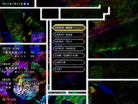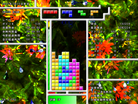Falling Down
| Falling Down | |
|---|---|
| Developer(s) | Ryuu Sakamoto |
| Platform(s) | Windows |
| Release | 2012 |
| Latest release | Version 6 printing 5 (2015-07-15) |
| Gameplay info | |
| Next pieces | 3 |
| Playfield size | 10 × 20 |
| Hold piece | Yes, with IHS |
| Hard drop | Yes |
| Rotation system | Unique |
Falling Down is a game made by Ryuu Sakamoto of Kirisame Zensen.
Game modes
Speed Road
Speed Road is based on pure Tetris play with no gimmicks (except for cascade blocks). The first 20 levels focus on increasing gravity until the game reaches 20G at level 21. After that, the mode slowly decreases line clear delay, lock delay and entry delay.
Chaos Road
Chaos Road is based on gimmick play. Each level has its own set of gimmicks that the player has to deal with. Gravity also increases, with level 46 and onwards being 20G.
Grade Test
Grade Test is based around a series of short courses that increase in difficulty. The grades start from 5-kyu, and clearing each course unlocks the next.
Each course is 10 levels, divided into 5 levels from Speed Road, followed by one level at 1/60 G, followed by three levels with layer obstructions, followed by one level with gimmicks.
Other Course
This is where user-made courses can be played.
Cascade Block system
The cascade system is based around the cascade gauge. The gauge is at the bottom of the screen, and fills as the player places pieces. Completing 4-line clears, T-Spins or combos will increase the gauge faster.
On filling the cascade gauge a piece will spawn containing a cascade block. If the player clears the cascade block the blocks above the row cleared will cascade downwards. If these cascading blocks clear a line the process repeats with the blocks above the cleared line, until there are no more lines to clear.
If the line clear activate the cascade block is a T-spin line clear, then all line clears in this cascade would be a T-spin line clear.
Engine details
Randomizer
The game uses a modified bag randomizer, intended to increase the alternation of S/Z pieces and J/L pieces.
Rotation system
The game engine implements a rotation system designed to be flexible and shape-agnostic.
The base rotation works the same in Sega Rotation/ARS. (World Block option only changes color to guideline colors.) There are no floor kicks. Wall kicks are checked in the following order:
| Situation | Test 1 | Test 2 | Test 3 | Test 4 | Test 5 | Test 6 | Test 7 |
|---|---|---|---|---|---|---|---|
| During Left DAS | ( 0, 0) | (-1, 0) | (-2, 0) | (-3, 0) | (+1, 0) | (+2, 0) | (+3, 0) |
| During Right DAS | ( 0, 0) | (+1, 0) | (+2, 0) | (+3, 0) | (-1, 0) | (-2, 0) | (-3, 0) |
| No DAS, CCW | ( 0, 0) | (-1, 0) | (+1, 0) | (-2, 0) | (+2, 0) | (-3, 0) | (+3, 0) |
| No DAS, CW | ( 0, 0) | (+1, 0) | (-1, 0) | (+2, 0) | (-2, 0) | (+3, 0) | (-3, 0) |
For the test to pass, the resulting piece must...
- not overlap with existing field blocks.
- AND overlap with at least one of pre-rotation piece's blocks.
If Test 7 fails, repeat all tests with 1 lower row ( 0, -1), then 2 lower rows ( 0, -2), then 3 lower rows ( 0, -3). If all tests fail, then the piece does not rotate.

